HTPC - TV Tuner Reviews
by Jarred Walton on December 7, 2005 12:05 AM EST- Posted in
- Smartphones
- Mobile
MyHD MDP-130
The Macro Image Technology (MIT) MyHD MDP-130 has a lot in common with the Fusion5 Gold. It, too, allows the viewing of QAM encoded channels as well as analog TV and OTA DTV broadcasts. You might be interested to know that both the Fusion5 and MyHD originate in Korea, apparently because Korea is one of the few countries that uses similar television standards to the US. Many of the bugs with the Fusion5 - and even MyHD - stem from the fact that Korea has far more strict standards in place for digital TV signals, so there aren't as many special cases that need to be programmed into the software. Besides the features and country of origin, there are quite a few other differences in the cards. Here's a shot of the card before we continue.
It should be immediately clear that this is a much larger card than the Fusion5. The added size comes with added features, so it's a worthwhile upgrade if you can afford it. First, two antenna inputs are supported, so you can connect an OTA DTV antenna as well as a cable connection, or an analog antenna and a digital antenna, or whatever other combination that you might come up with. While there are two inputs, it's important to note that this is not a dual-tuner card - you can't watch one channel and record another, or record two channels simultaneously. (You can't even use the software to watch one recorded broadcast while recording a new broadcast, though that feature appears to be on the wish list for both the Fusion and the MyHD. You can use a second application, but that's not the same thing.)
The major difference between the Fusion and the MyHD is that where the Fusion5 (and many other TV tuners) are predominantly software products for decoding, the MyHD features hardware-based decoding. The benefit of hardware decoding is that processor speed requirements are very reasonable - in fact, a second-hand PC is probably sufficient. The minimum system requirements list a Pentium II 400 MHz with 64MB of RAM. We didn't test in anything anywhere near that outdated, but we can say that CPU usage with our Sempron system remained very low. Even with the overlay window stretched to fill the 1280x720 output (which requires more processing power), CPU usage is well below 20% when watching digital channels. Analog channels are a different story, which we'll get to in a moment.
Like all the other cards in this article, a remote is included with the MyHD along with a USB receiver. The MyHD is the smallest of the remotes, and it also omits many of the extra buttons that are present on the other remotes. Personally, the lack of a "PC Power" button is appreciated. If you want the PC to enter sleep mode or shut down, you can set that as a configuration option, and that's the best way to approach this feature. The only button that I never found useful is the "subchannel" button. If you disable the virtual channel mode, it allows you to switch between sub-channels. I preferred the virtual channel mode.
The rear of the card features a large output connection that attaches to the above cable. Similar to other pass-thru cards in the past, a three-port cable that connects to the video card's VGA port as well as the MyHD card, and the display is provided. (This cable is often jokingly referred to as the "octopus cable".) S-VIDEO and Composite inputs are also an option on a fourth connection, though we didn't use those since we were connected to an HDTV.
Switching to "HD mode" - either by pressing the "HD" button on the remote or by double-clicking the video window - bypasses the graphics card output and uses the output of the MyHD card instead. The software allows you to configure the resolution and type of display used, with most standard resolutions available. (You can find the complete list of supported resolutions at Digital Connections - the specs listed there are actually more accurate than the specs on the MIT site, in case you were wondering.)
The problem with the HD mode is that it only works properly with a VGA display or component connections (a separate VGA-to-component cable is required, but you can get it packaged with the card at many places), but not with a DVI output. If you want to use a DVI port, the solution is to get the additional DVI daughtercard pictured above, the MDP-130DVI. We'd prefer to get everything in one package, and a single slot solution would be nice. However, finding room for both VGA and DVI outputs along with the coaxial connections is almost impossible. A breakout box could suffice, but that would increase costs for all users rather than only those who want to use a DVI port.
Besides VGA or DVI (with daughtercard), there are additional ways of using the MyHD card. As we discussed earlier, ATI cards had a problem with the DVI connection when hooked up to an HDTV. That problem occurs with or without the MDP-130DVI card, making ATI+DVI an unacceptable solution in our view. If you want to get creative, you can try chaining together a few dongles and cables to get the component output of an ATI card to route through the VGA connections of the MyHD "octopus" cable. We didn't try that, and it may not actually work.
If you want something that will work, pick up a transcoder that will convert the VGA RGBHV signal into a component signal. The Audio Authority 9A60 will handle that task, and while it costs more than the DVI daughtercard, it is also more flexible. Feeding the VGA output of the octopus into the transcoder and then using component cables to connect the transcoder to the display will then work.
We tested with both the DVI card as well as the VGA connection going to a PC monitor. For the VGA connection, any standard PC monitor can be used. For someone in a small apartment or college dorm, that might be sufficient, but watching TV on a computer display generally isn't as pleasing as using a larger TV. You can also use the MyHD in dual-display mode, with a standard monitor and either the DVI, VGA, or VGA-to-component cable to connect to a secondary display. If you have a PC near your HDTV, you can even have MyHD showing and/or recording a broadcast while the PC is used for other tasks without difficulty.
The Macro Image Technology (MIT) MyHD MDP-130 has a lot in common with the Fusion5 Gold. It, too, allows the viewing of QAM encoded channels as well as analog TV and OTA DTV broadcasts. You might be interested to know that both the Fusion5 and MyHD originate in Korea, apparently because Korea is one of the few countries that uses similar television standards to the US. Many of the bugs with the Fusion5 - and even MyHD - stem from the fact that Korea has far more strict standards in place for digital TV signals, so there aren't as many special cases that need to be programmed into the software. Besides the features and country of origin, there are quite a few other differences in the cards. Here's a shot of the card before we continue.
It should be immediately clear that this is a much larger card than the Fusion5. The added size comes with added features, so it's a worthwhile upgrade if you can afford it. First, two antenna inputs are supported, so you can connect an OTA DTV antenna as well as a cable connection, or an analog antenna and a digital antenna, or whatever other combination that you might come up with. While there are two inputs, it's important to note that this is not a dual-tuner card - you can't watch one channel and record another, or record two channels simultaneously. (You can't even use the software to watch one recorded broadcast while recording a new broadcast, though that feature appears to be on the wish list for both the Fusion and the MyHD. You can use a second application, but that's not the same thing.)
The major difference between the Fusion and the MyHD is that where the Fusion5 (and many other TV tuners) are predominantly software products for decoding, the MyHD features hardware-based decoding. The benefit of hardware decoding is that processor speed requirements are very reasonable - in fact, a second-hand PC is probably sufficient. The minimum system requirements list a Pentium II 400 MHz with 64MB of RAM. We didn't test in anything anywhere near that outdated, but we can say that CPU usage with our Sempron system remained very low. Even with the overlay window stretched to fill the 1280x720 output (which requires more processing power), CPU usage is well below 20% when watching digital channels. Analog channels are a different story, which we'll get to in a moment.
 |
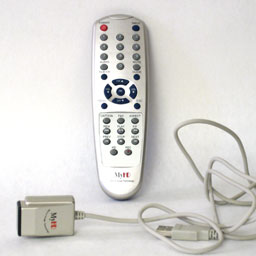 |
| Click to enlarge. | |
Like all the other cards in this article, a remote is included with the MyHD along with a USB receiver. The MyHD is the smallest of the remotes, and it also omits many of the extra buttons that are present on the other remotes. Personally, the lack of a "PC Power" button is appreciated. If you want the PC to enter sleep mode or shut down, you can set that as a configuration option, and that's the best way to approach this feature. The only button that I never found useful is the "subchannel" button. If you disable the virtual channel mode, it allows you to switch between sub-channels. I preferred the virtual channel mode.
The rear of the card features a large output connection that attaches to the above cable. Similar to other pass-thru cards in the past, a three-port cable that connects to the video card's VGA port as well as the MyHD card, and the display is provided. (This cable is often jokingly referred to as the "octopus cable".) S-VIDEO and Composite inputs are also an option on a fourth connection, though we didn't use those since we were connected to an HDTV.
Switching to "HD mode" - either by pressing the "HD" button on the remote or by double-clicking the video window - bypasses the graphics card output and uses the output of the MyHD card instead. The software allows you to configure the resolution and type of display used, with most standard resolutions available. (You can find the complete list of supported resolutions at Digital Connections - the specs listed there are actually more accurate than the specs on the MIT site, in case you were wondering.)
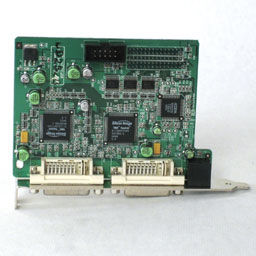 |
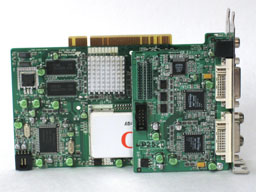 |
| Click to enlarge. | |
The problem with the HD mode is that it only works properly with a VGA display or component connections (a separate VGA-to-component cable is required, but you can get it packaged with the card at many places), but not with a DVI output. If you want to use a DVI port, the solution is to get the additional DVI daughtercard pictured above, the MDP-130DVI. We'd prefer to get everything in one package, and a single slot solution would be nice. However, finding room for both VGA and DVI outputs along with the coaxial connections is almost impossible. A breakout box could suffice, but that would increase costs for all users rather than only those who want to use a DVI port.
Besides VGA or DVI (with daughtercard), there are additional ways of using the MyHD card. As we discussed earlier, ATI cards had a problem with the DVI connection when hooked up to an HDTV. That problem occurs with or without the MDP-130DVI card, making ATI+DVI an unacceptable solution in our view. If you want to get creative, you can try chaining together a few dongles and cables to get the component output of an ATI card to route through the VGA connections of the MyHD "octopus" cable. We didn't try that, and it may not actually work.
If you want something that will work, pick up a transcoder that will convert the VGA RGBHV signal into a component signal. The Audio Authority 9A60 will handle that task, and while it costs more than the DVI daughtercard, it is also more flexible. Feeding the VGA output of the octopus into the transcoder and then using component cables to connect the transcoder to the display will then work.
We tested with both the DVI card as well as the VGA connection going to a PC monitor. For the VGA connection, any standard PC monitor can be used. For someone in a small apartment or college dorm, that might be sufficient, but watching TV on a computer display generally isn't as pleasing as using a larger TV. You can also use the MyHD in dual-display mode, with a standard monitor and either the DVI, VGA, or VGA-to-component cable to connect to a secondary display. If you have a PC near your HDTV, you can even have MyHD showing and/or recording a broadcast while the PC is used for other tasks without difficulty.


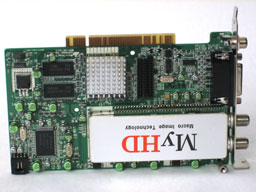

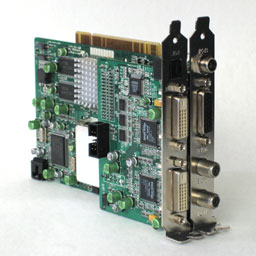
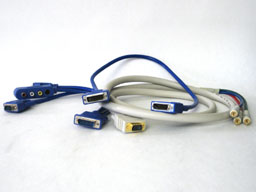








77 Comments
View All Comments
JarredWalton - Thursday, December 8, 2005 - link
The only system it impacted was the MyHD for analog. I did perform most of the tests at stock clock speeds. But yeah, I should probably make that note. (The X2 was overclocked to 2.6 GHz as well, if you didn't notice, but I only tested the MyHD card in that system.)The Boston Dangler - Wednesday, December 7, 2005 - link
"While the Toshiba 46H84 is in fact a 1080i display - or really a 1920x540p display, if I understand it correctly"The display has 1080 horizontal lines of resolution, scanned alternately. 1080i format signals carry data roughly equivalent of 540p.
My opinion: Having owned both 1080i and 720p sets, and watching programs in their native formats, the difference in pic quality is entirely upon the display. There are both formats present in OTA/Cable, something always gets converted. Either format can provide great pics, even after conversion. It's all about the display.
"The onscreen Guide also doesn't work for me - it shows up blank - but this appears to be at least partly Comcast's fault. The FusionHDTV software is supposed to read the EPG information from the channel stream, but Comcast isn't including that in my area, as far as I can tell. (This was a problem on the MyHD as well, so that lends credence to the assumption that the local Comcast provider is to blame.)"
EPG is usually considered an extra service by content providers, thus a cable box and subscription are required. There are online alternatives, sometimes with handy plugins.
slashdotcomma - Wednesday, December 7, 2005 - link
What's the lag between signal and display? Would I be able to use any of these tuner cards and play on a gamecube,xbox(360),ps2/3, etc?JarredWalton - Wednesday, December 7, 2005 - link
I'm not quite sure what you mean. Are you trying to capture videos of your gameplay? Or just get the game console input onto your computer screen? Tuning to digital channels introduces about a two second lag, and on analog channels it's more like a .5 second to one second lag. Obviously, neither of those would be acceptable for gaming. It sounds like what you really want would be some form of transcoder?Note: it never even occurred to me to test this aspect of the cards, and I don't have a game console with which to test it. Sorry -- I'm a PC gamer. :-)
slashdotcomma - Wednesday, December 7, 2005 - link
Yes, I'm trying to get the game console input onto my computer screen. Lag for changing channels and lag between signal and screen is slightly different. For example, I played around with an AIW-9800 pro and changing channels would introduce a slight lag, but playing game consoles on it was beautiful. No lag, and everything was smooth as silk (p42.8c, 1gb ram, don't remember which MMC v9 it was). Actually it doesn't even have to be a video console, try plugging in a dvd player or vcr and try moving around in the menu. I wish more reviewers would add this to part of their reviews. I plan on playing around with Dscaler if I get the chance. There are ways to hook up game consoles to computer screen but you lose the recording ability and in some cases DVI support. Do you have a chance to play around with the older tv tuners as well?JarredWalton - Wednesday, December 7, 2005 - link
I don't have any older TV Tuners, though Anand might still have some of them. I'll have to see if I can get a game console over to try out in this fashion. I might actually have an N64 boxed up somewhere. I use PCs for DVD watching, and I don't have a VCR either, so it's going to take a bit of work. I do know that if I tune in the Comcast box to an analog channel and at least one or two of the tuners (I don't recall which), they were not in sync with each other; the Comcast was slightly ahead all the time, so it seems like lag is present.sprockkets - Wednesday, December 7, 2005 - link
I record for example LOST from the s-video out on my HDTV receiver, and it goes to a Lite On recorder on highest quality, and if you see it you would be hard pressed to tell the difference. Or, you can simply record 720x480 at a high quality via s-video in and get the same results on these cards. Of course that means setting up two devices.Does HDTV recording from these cards preserve the Dolby Digital 5.1 signal as well?
segagenesis - Wednesday, December 7, 2005 - link
Yes, they should. If you have ever checked out any of the Lost tv torrents you would be familiar that this is possible also ;)vailr - Wednesday, December 7, 2005 - link
ATI's MMC v. 9.10 may work with 550 tuner cards, according to this thread:http://www.rage3d.com/board/showthread.php?t=33835...">ATI words on MMC 9.10: Dual-tuner MulTView + 550 support!
Combined with their Gemstar GuidePlus software, would enable an electronic program guide.
Note: MMC 9.10 is not currently available on ATI's web site; only on the software CD provided with their latest XT180AIW card.
vailr - Wednesday, December 7, 2005 - link
The link is for the older PCI version, not the currently reviewed PCIe version.